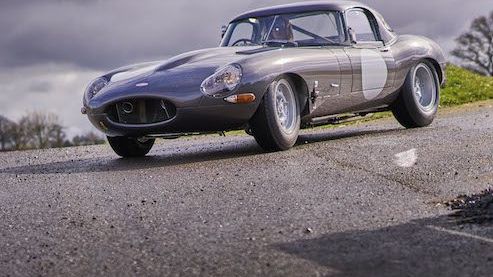

Words: Rory FH Smith
It’s late on a muggy Monday evening in Berkeley Square, Mayfair and I’m at a car launch. There’s nothing unusual about that but the car before me was first made in 1963. A rather late launch ceremony, you may think, but this is no anniversary celebration either, this is a brand spanking new, old car – confusingly – and it’s called the Jaguar E-Type Lightweight Continuation.
This gunmetal grey Jaguar is one of ‘the missing six’ – the six unbuilt cars of the proposed 18 that Jaguar didn’t build in the first production run of the Lightweight E-Type between 1963 and 1964. The decision to complete the production run and reproduce the model, to its exact period specification, was taken by Jaguar Land Rover SVO (Special Vehicle Operations). After years of scouring the country for the right materials, engineers and components, the missing six now exist as complete, race-ready Lightweight E-Types. But before you get excited, gentlemen, they’ve all been sold – despite their £1.5million asking price.
The six cars are beautiful, in every respect, and each unique in terms of their specification. From the carefully crafted custom coachwork to the smell of the leather lining the bucket seats. Seeing one of the missing six in the metal is a rare treat on a Monday evening, but seeing one of the original cars roar past in the 1960s must have been a truly momentous occasion indeed. And here lies a dilemma: is a continuation project a form of shrewd preservation or sullying the name of the original masterpieces?
It’s a tough one – if I had a beard I’d be stroking it with a perplexed look on my face. Ford GT40s, AC Cobras, and even Aston Martin DB4 GT Zagatos have been replicated on a commercial basis for decades. There’s also the ‘restomods’ or backdated cars, which are original classic cars with modern, more reliable underpinnings like the Eagle E-Types, for example. Where Jaguar SVO fits on this scale, however, is at the very top. Why? Because the missing six Lightweights are as true to the 1960s originals as is possible in this new millennia of manufacturing. These very special six Jag’s even feature the same spot welding patterns as the original 12 cars.
But no matter how authentic the recreation process, there’s no escaping that it is, by all accounts, a new car; made in a new factory, with new technology on hand. For example, the dimensions of the missing six Lightweights were recreated by digitally scanning car number 12, the last Lightweight off the original production line in 1964. Digital scanning? A 1960s technology, I think not. The old Jaguar boys in brown coats would be choking on their cigars.
But still, there’s something significant missing from the recipe, because what can never be recreated is history and heritage. The sweat, tears and oil stains from decades of competition driving. The awe-inspiring moments when the world first witnessed the roar and crackle of these 1960s racetrack warriors. Now that, gentleman, is something no amount of money or technical know-how can instill. By all means respect the car for what it is – a beautiful and accomplished example of automotive engineering – but there’s something not quite right about pulling onto the Goodwood circuit with only delivery miles on the clock.


